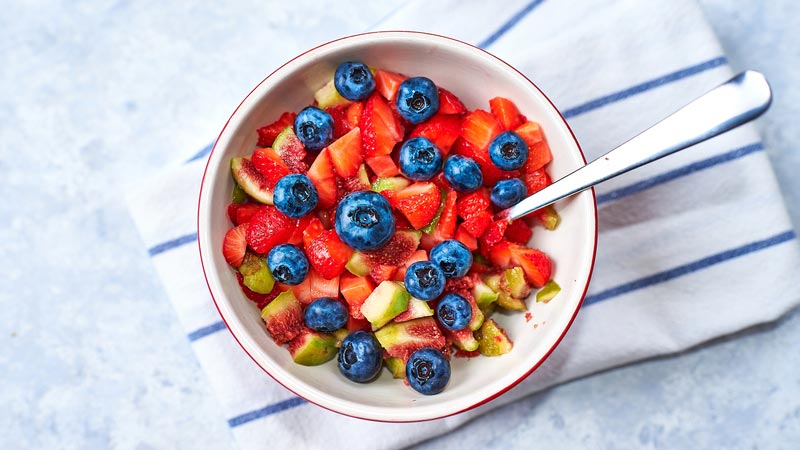
Fruit has long been a much celebrated part of Australian culture, and due to our varied climate, we produce a wide range of delicious fruit, from tropical papaya and pineapples to apples and pears. Despite this, fruit is often in the media spotlight with people often questioning whether it is high in sugar, fattening or healthy to consume.
Much of the health debate when it comes to fruit is based around a single compound that is very commonly available in our Aussie diet: sugar. Sugar is a simple carbohydrate that our body uses for fuel. The most common sugar in our bodies is glucose, which our brain, organs and muscles rely on for daily function. There are several other naturally occurring sugars in our food supply including the lactose in dairy foods, fructose in fruit and sucrose which is also known as table sugar. These, when consumed, are also broken down to glucose for energy, but if we have too much they can be stored as body fat. And yes – some people do tend to eat too much refined sugar. But is it fruit that’s pushing us over the edge? The evidence suggests this is unlikely. An excess intake of added sugars in processed foods and sugary drinks is associated with obesity, high blood lipids and even non-alcoholic fatty liver disease, but these results do not extend to the sugars naturally occurring in fruit. This is believed to be because fruit has a lot more to offer than just the sum of its sugar content.
In fact, a 2019 study which reviewed the evidence on whole fresh fruit consumption on energy intake and weight gain found that increasing whole, fresh fruit consumption promotes weight maintenance with modest protection against weight gain over five or more years. Furthermore, the researchers found consuming whole, fresh fruit tends to decrease caloric intake, particularly when consumed prior to a meal or when replacing more calorie dense foods.
Here are our top five reasons to include fruit in your diet!
1. To boost your daily fibre intake.
Fibre is the part of plants we are unable to digest. Because we do not possess the machinery to break it down it stays intact until it reaches the last part of our digestive system called our large bowel or colon. It is here inside our large bowel that our resident microbes called our gut microbiota live. Fibre is their primary fuel source and inside the large bowl fibre is fermented into beneficial health compounds which are essential for our health. Despite being essential for good health, unfortunately less than 30% of Australian adults meet the adequate intake (AI) for fibre.
Fibre is not only essential for good gut health. An increased intake of fibre is linked to a reduced risk of:
- >> Colorectal cancer
- >> High blood pressure
- >> Coronary Heart Disease
- >> Stroke
- >> Type two diabetes
- >> Obesity
The Suggested Dietary Target (SDT) to reduce the risk of chronic disease is 38g for men and 28g for women. Food is a fantastic source of dietary fibre.
Here are some of our favourite high fibre fruits
- >> 1 x pear or apple = 3.5g fibre
- >>> 1 cup strawberries = 3.5g fibre
- >> 1 x banana = 2.5g fibre
- >> 1 x orange = 2.5g fibre
- >> 4 x prunes = 2.5 fibre
- >> 2 x kiwifruit = 4.5g fibre
2. They’re a good source of prebiotics
A prebiotic is a type of fibre, but not all fibres are prebiotics. To be classified as a prebiotic, the fibre must pass through the digestive system undigested and stimulate the growth and/or activity of certain ‘good’ bacteria in the large intestine. That is, they only nourish the good bugs in your gut!
Some health benefits associated with consuming prebiotics includes:
- >> Positively influencing the gut microbiota
- >> Improving mineral absorption
- >> Potentially protecting against colon cancer
- >> Improved blood glucose and insulin control
- >> Protection against intestinal infections
- >> Reducing the inflammation associated with some conditions
Consuming prebiotics is one way to boost gut function! Fruits that are good sources of prebiotics include custard apples, nectarines, white peaches, persimmon, tamarillo, watermelon, grapefruit, pomegranate and dried fruit such as dates and figs.
3. They’re a good source of carbohydrates
The fruit sugar fructose found in fruit is a carbohydrate, but not all carbohydrate foods are created equal. Some carbohydrates are broken down quickly by the body, creating a spike in our blood glucose levels, while others cause a slow trickle of sugar into the blood. These more slowly released carbohydrates have a lower glycaemic index (GI) – they help to moderate our energy levels over a longer period, help us feel fuller for longer (as we don’t end up with a dip in blood sugar levels once the ‘sugar rush’ wears off) and produce a more balanced insulin response. Most fruits are low GI.
4. They contain powerful plant chemicals
Phytochemicals are a special group of plant chemicals found exclusively in plant foods such as fruits, vegetables, whole-grains, nuts, seeds, and legumes. There are literally thousands of them and despite not being ‘essential’ for our health such as vitamins, they play an important role in keeping us health.
Phytochemicals contribute to the color, taste, and smell of plant-foods. For example, they give carrots their vibrant orange hue (beta-carotene) and tomatoes their bright red colour (lycopene) Phytochemicals are found in all edible parts of a plant, especially in the skin or peel which is why you should always try and include these in the cooking process.
Phytochemicals are often antioxidants and research shows they may help reduce:
- >> Inflammation
- >> Cell Damage
- >> The growth of ‘bad’ bacteria and stimulate growth of ‘good’ bacteria
Many fruits are a valuable source of phytochemicals. For example:
- >> Berries contain a special group of phytochemicals called flavonoids which have been shown to play a role in heart health and the prevention of heart disease, as well as cognitive decline.
- >> Grapes and apples contain a special group of phytochemicals called proanthocyanidins and flavanols which are linked to better function of the lining of the arteries and reduced blood pressure
- >> Apples and citrus fruit contain a special phytochemical called quercetin which may help decrease inflammation and blood pressure.
Take home message
While it’s a good idea to limit your intake of added sugars, all the evidence points towards the health benefits of regularly including whole fresh fruit in your diet. We are unable to blame the poor health of our nation on consuming too much fruit with less than 50% of Adults and less than 70% of children currently meeting the recommended serves of fruit per day.
Adults should aim for 2+ serves of fruit per day with 1 serve being equivalent to 1 cup of chopped fruit or 1 medium piece of fruit. Fruit should not be reduced to one nutrient (sugar) and should be viewed as a nutrient dense food rich in vitamins, minerals, fibre and plant chemicals. Choose fresh, rather than dried fruit or juice as often as possible.
To learn more book a consultation with Eatsense by clicking Here or read more about Eatsense Here
